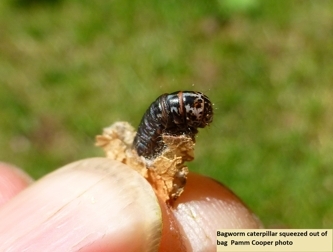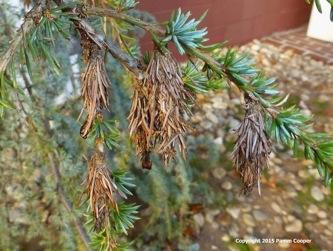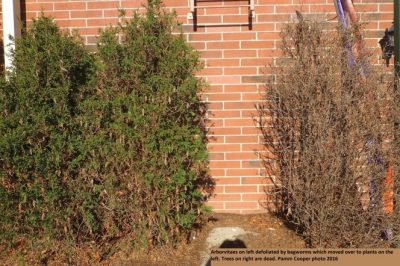Thyridopteryx ephemeraeformis (Haworth)
The Bagworm moth is in the family Lepidoptera, genus Psychidae, and is named for the bag constucted by the caterpillar from its silk and the foliage of the host plant. The bags are attached to twigs with a silken girdle and dangle down, often masked becuae of the foliage stuck to the outside on the bags. It is a serious pest of ornamental trees and shrubs in the eastern part of the United States, in particular the conifers like arborvitae, cedar, juniper, and pine. It now feeds on other host plants in Connecticut such as oaks, cherry, willow and other deciduous trees. The adult female lacks eyes, has only vestigial wings and cannot fly. The sooty black adult male has nearly transparent wings and underdeveloped mouthparts. The dirty gray mature larvae are splotched with darker markings toward the head and are about ¾ to 1” long when it is time to pupate inside the bag.
Life Cycle

Bagworm larvae hatch from late May through early June from the 500-1000 smooth and cylindrical eggs that were laid by the adult female the prior fall. The larvae are 7/100ths of an inch long and disperse by spinning a silken thread that allows them to balloon on the wind to nearby plants. The larvae begin to feed and as they do so they construct their own bag out of twigs, leaves and the same silk. The larvae carry this bag around with them as they feed with only their head and thorax sticking out of the bag. As the larvae grow through 7 instar stages they enlarge the bag to almost 2” long to accommodate their size. At the end of the summer the bagworm larvae stop feeding, securely attach their bag to a stem, twig or other structure and seal the bag shut. This bag is the most recognizable aspect of the bagworm as it hangs from the branch of the host tree.
 The pupal stage lasts for 4 weeks until September and early October. At this point the wingless adult female moth will not leave the bag but will release a pheromone that will attract the male moth. The winged adult male moths will emerge from their bags and fly around to locate a female. Once found, the male moth will insert his abdomen into the bag containing the adult female for fertilization. Once the female has mated, she will stop producing the pheromone, deposit her egg mass inside of the bag, and will either stay within the bag to die and mummify or drop to the ground. Due to underdeveloped mouthparts that prevent them from feeding, the adult males survive only long enough to reproduce. The eggs remain in the bags on the trees till the following spring and hatch about mid-June to start the cycle over.
The pupal stage lasts for 4 weeks until September and early October. At this point the wingless adult female moth will not leave the bag but will release a pheromone that will attract the male moth. The winged adult male moths will emerge from their bags and fly around to locate a female. Once found, the male moth will insert his abdomen into the bag containing the adult female for fertilization. Once the female has mated, she will stop producing the pheromone, deposit her egg mass inside of the bag, and will either stay within the bag to die and mummify or drop to the ground. Due to underdeveloped mouthparts that prevent them from feeding, the adult males survive only long enough to reproduce. The eggs remain in the bags on the trees till the following spring and hatch about mid-June to start the cycle over.
Damage

Young bagworm larvae feed on the upper epidermis of leaves and needles, often leaving small holes in the foliage. The mature larvae will do more extensive damage, particularly to evergreens. Bagworm infestations can go unnoticed until the damage has already been done and the bags become apparent. Deciduous trees can recover defoliation in the following year although as the bagworm larvae do not travel very far from their hatching bag so the same plant may experience bagworm issues in consecutive years. It is a good idea to check plants that have already had bagworm populations in consecutive years.
Control Measures
- Scout trees and shrubs (especially those that have had a prior infestation) for the bags or pods.
- Bags hanging on the trees in the fall and winter contain the eggs for the next generation.
- Remove from small trees by hand and discard any time before June. Crush and dispose of the bags to keep the bagworm from re-infesting an area.
- Handpicked bagworms can be placed in a bucket with soapy water or a sealed bag.
- Caterpillars emerge from overwintering eggs within the bag in June.
-

Photo by Pamm Cooper, UConn Home & Garden Education Center (2016) Bacillus thuringiensis Kurstaki (Btk) can be applied between mid-June and mid-July. This product works best on young bagworms.
- Pyrethroid insectides are effective when sprayed on foliage as the caterpillars will ingest the insecticide as they feed on treated foliage.
- In certain weather conditions, entomopathogenic nematodes (esp. Steinernema carpocapsae) have been shown to provide control of bagworm larvae.
- The common bagworm is attacked by at least 11 species of parasitic wasps including the ichneumonid parasitoid wasps Pimpla disparis, Itoplectis conquisitor, and Gambrus ultimus.
- Predators of bagworms include white footed mice and sparrows.
- Chemical control becomes less effective as the season progresses because of the increased size of the larva and its protective bag.
- READ THE LABEL on each pesticide container before each use. Apply as directed. Heed all warnings and precautions. Store pesticides in their original labeled containers out of reach of children, irresponsible people and pets, preferable under lock and key. Dispose of empty containers safely.
Despite good cultural practices, pests and diseases at times may appear. Chemical control should be used only after all other methods have failed. For pesticide information please call UConn Home and Garden Education Center or your local cooperative extension office.
The UConn Home & Garden Education Center supports UConn Extension’s mission by providing answers you can trust with research-based information and resources. For gardening questions, contact us toll-free at (877) 486-6271, visit our website at homegarden.cahnr.uconn.edu, or reach out to your local UConn Extension center at cahnr.uconn.edu/extension/locations.
Revised by UConn Home and Garden Education Center 2021.